Corporate Accounting 1: Analysis of Cash Generating Unit Impairment
VerifiedAdded on 2023/06/04
|7
|1505
|338
Report
AI Summary
This report provides a comprehensive analysis of asset impairment within the context of corporate accounting. It explains the concept of impairment, which occurs when the recoverable amount of an asset falls below its carrying amount, resulting in an impairment loss. The report defines a cash generating unit (CGU) as the smallest group of assets that generates independent cash flows and outlines how to identify these units based on management policies. It details the calculation of impairment loss, emphasizing the importance of determining the recoverable amount, which is the higher of an asset's value in use and its fair value less selling costs. The report addresses the allocation of impairment losses to goodwill and other assets, including journal entries to record the loss, and discusses the treatment of non-cash-generating assets within a CGU. It also covers the reversal of impairment losses and the required disclosures in financial statements. Part B of the report provides a practical example with provided figures, illustrating the calculation of impairment loss for a specific CGU, including the allocation of the loss across different assets and the corresponding journal entries. The report concludes by emphasizing the importance of accurate impairment calculations and disclosures for reliable financial reporting. The report includes a detailed bibliography of sources used.
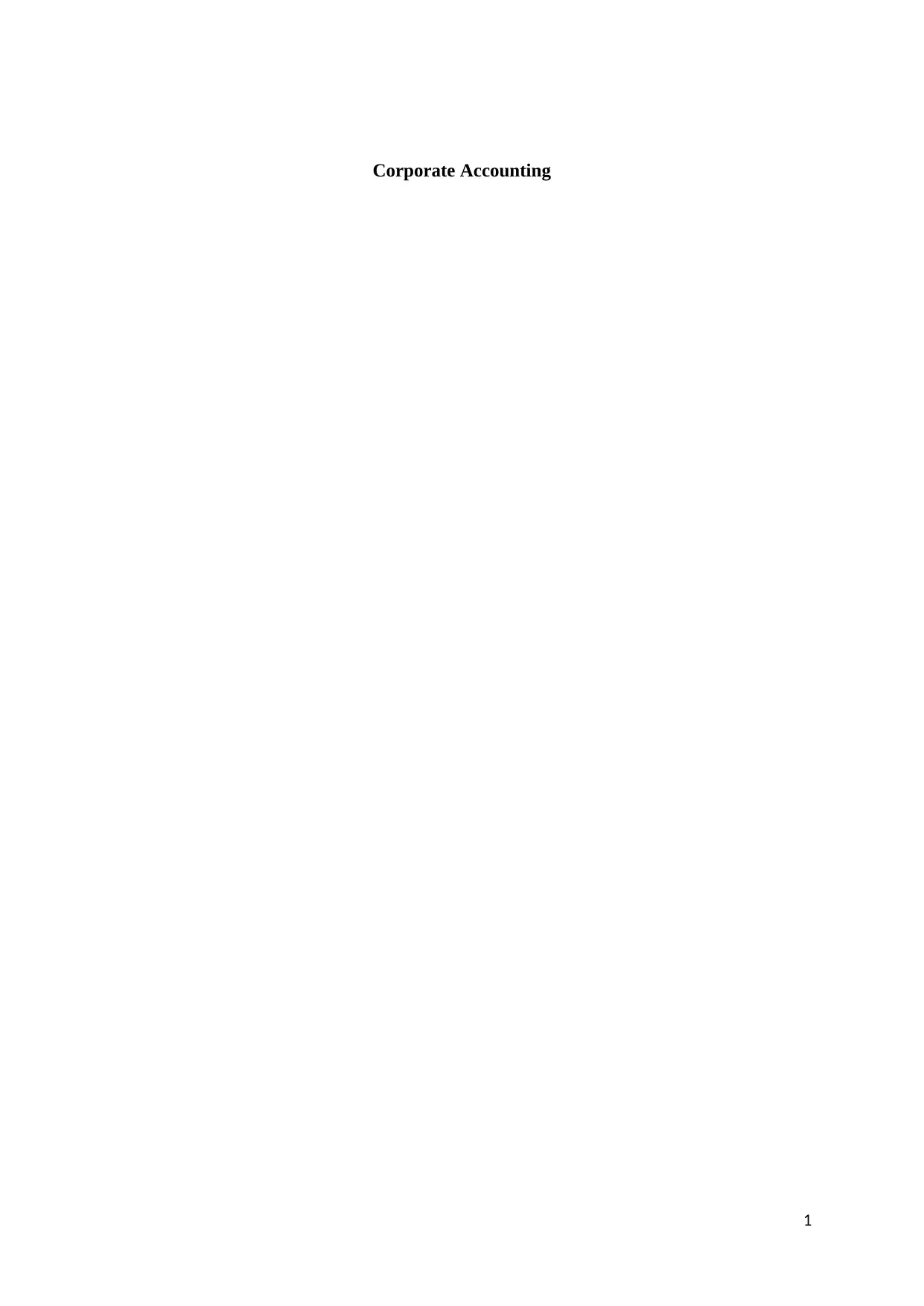
Corporate Accounting
1
1
Paraphrase This Document
Need a fresh take? Get an instant paraphrase of this document with our AI Paraphraser
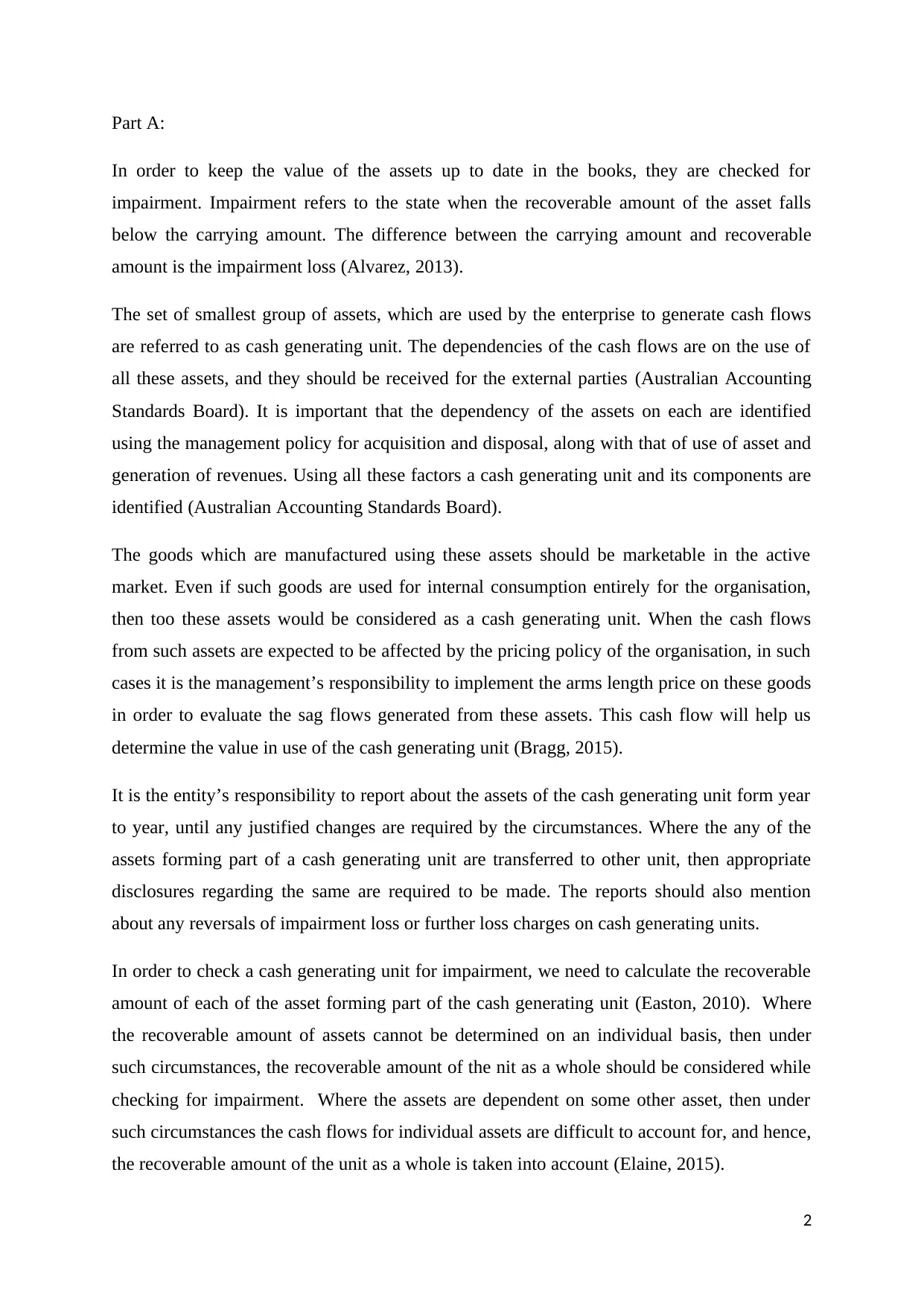
Part A:
In order to keep the value of the assets up to date in the books, they are checked for
impairment. Impairment refers to the state when the recoverable amount of the asset falls
below the carrying amount. The difference between the carrying amount and recoverable
amount is the impairment loss (Alvarez, 2013).
The set of smallest group of assets, which are used by the enterprise to generate cash flows
are referred to as cash generating unit. The dependencies of the cash flows are on the use of
all these assets, and they should be received for the external parties (Australian Accounting
Standards Board). It is important that the dependency of the assets on each are identified
using the management policy for acquisition and disposal, along with that of use of asset and
generation of revenues. Using all these factors a cash generating unit and its components are
identified (Australian Accounting Standards Board).
The goods which are manufactured using these assets should be marketable in the active
market. Even if such goods are used for internal consumption entirely for the organisation,
then too these assets would be considered as a cash generating unit. When the cash flows
from such assets are expected to be affected by the pricing policy of the organisation, in such
cases it is the management’s responsibility to implement the arms length price on these goods
in order to evaluate the sag flows generated from these assets. This cash flow will help us
determine the value in use of the cash generating unit (Bragg, 2015).
It is the entity’s responsibility to report about the assets of the cash generating unit form year
to year, until any justified changes are required by the circumstances. Where the any of the
assets forming part of a cash generating unit are transferred to other unit, then appropriate
disclosures regarding the same are required to be made. The reports should also mention
about any reversals of impairment loss or further loss charges on cash generating units.
In order to check a cash generating unit for impairment, we need to calculate the recoverable
amount of each of the asset forming part of the cash generating unit (Easton, 2010). Where
the recoverable amount of assets cannot be determined on an individual basis, then under
such circumstances, the recoverable amount of the nit as a whole should be considered while
checking for impairment. Where the assets are dependent on some other asset, then under
such circumstances the cash flows for individual assets are difficult to account for, and hence,
the recoverable amount of the unit as a whole is taken into account (Elaine, 2015).
2
In order to keep the value of the assets up to date in the books, they are checked for
impairment. Impairment refers to the state when the recoverable amount of the asset falls
below the carrying amount. The difference between the carrying amount and recoverable
amount is the impairment loss (Alvarez, 2013).
The set of smallest group of assets, which are used by the enterprise to generate cash flows
are referred to as cash generating unit. The dependencies of the cash flows are on the use of
all these assets, and they should be received for the external parties (Australian Accounting
Standards Board). It is important that the dependency of the assets on each are identified
using the management policy for acquisition and disposal, along with that of use of asset and
generation of revenues. Using all these factors a cash generating unit and its components are
identified (Australian Accounting Standards Board).
The goods which are manufactured using these assets should be marketable in the active
market. Even if such goods are used for internal consumption entirely for the organisation,
then too these assets would be considered as a cash generating unit. When the cash flows
from such assets are expected to be affected by the pricing policy of the organisation, in such
cases it is the management’s responsibility to implement the arms length price on these goods
in order to evaluate the sag flows generated from these assets. This cash flow will help us
determine the value in use of the cash generating unit (Bragg, 2015).
It is the entity’s responsibility to report about the assets of the cash generating unit form year
to year, until any justified changes are required by the circumstances. Where the any of the
assets forming part of a cash generating unit are transferred to other unit, then appropriate
disclosures regarding the same are required to be made. The reports should also mention
about any reversals of impairment loss or further loss charges on cash generating units.
In order to check a cash generating unit for impairment, we need to calculate the recoverable
amount of each of the asset forming part of the cash generating unit (Easton, 2010). Where
the recoverable amount of assets cannot be determined on an individual basis, then under
such circumstances, the recoverable amount of the nit as a whole should be considered while
checking for impairment. Where the assets are dependent on some other asset, then under
such circumstances the cash flows for individual assets are difficult to account for, and hence,
the recoverable amount of the unit as a whole is taken into account (Elaine, 2015).
2
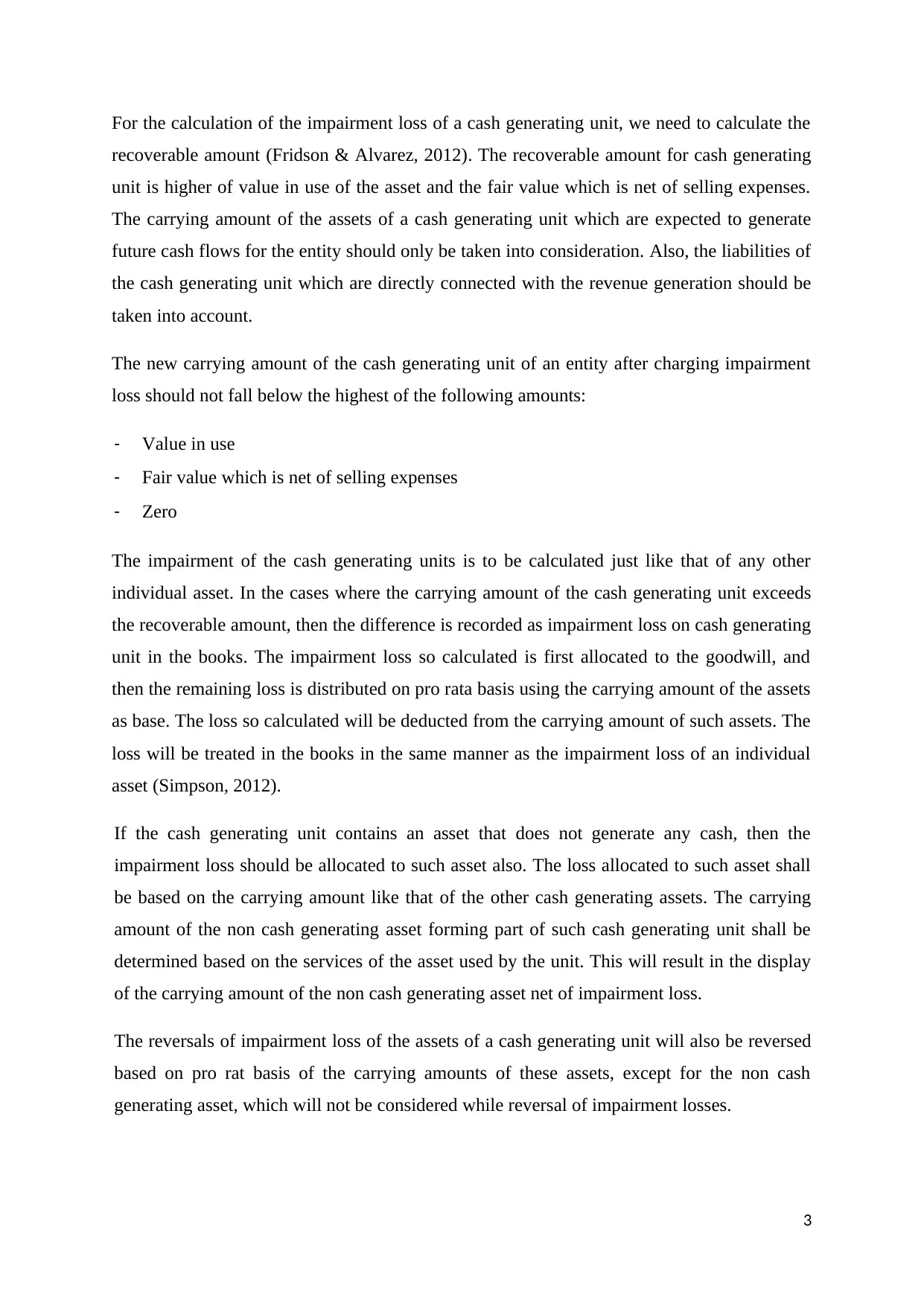
For the calculation of the impairment loss of a cash generating unit, we need to calculate the
recoverable amount (Fridson & Alvarez, 2012). The recoverable amount for cash generating
unit is higher of value in use of the asset and the fair value which is net of selling expenses.
The carrying amount of the assets of a cash generating unit which are expected to generate
future cash flows for the entity should only be taken into consideration. Also, the liabilities of
the cash generating unit which are directly connected with the revenue generation should be
taken into account.
The new carrying amount of the cash generating unit of an entity after charging impairment
loss should not fall below the highest of the following amounts:
- Value in use
- Fair value which is net of selling expenses
- Zero
The impairment of the cash generating units is to be calculated just like that of any other
individual asset. In the cases where the carrying amount of the cash generating unit exceeds
the recoverable amount, then the difference is recorded as impairment loss on cash generating
unit in the books. The impairment loss so calculated is first allocated to the goodwill, and
then the remaining loss is distributed on pro rata basis using the carrying amount of the assets
as base. The loss so calculated will be deducted from the carrying amount of such assets. The
loss will be treated in the books in the same manner as the impairment loss of an individual
asset (Simpson, 2012).
If the cash generating unit contains an asset that does not generate any cash, then the
impairment loss should be allocated to such asset also. The loss allocated to such asset shall
be based on the carrying amount like that of the other cash generating assets. The carrying
amount of the non cash generating asset forming part of such cash generating unit shall be
determined based on the services of the asset used by the unit. This will result in the display
of the carrying amount of the non cash generating asset net of impairment loss.
The reversals of impairment loss of the assets of a cash generating unit will also be reversed
based on pro rat basis of the carrying amounts of these assets, except for the non cash
generating asset, which will not be considered while reversal of impairment losses.
3
recoverable amount (Fridson & Alvarez, 2012). The recoverable amount for cash generating
unit is higher of value in use of the asset and the fair value which is net of selling expenses.
The carrying amount of the assets of a cash generating unit which are expected to generate
future cash flows for the entity should only be taken into consideration. Also, the liabilities of
the cash generating unit which are directly connected with the revenue generation should be
taken into account.
The new carrying amount of the cash generating unit of an entity after charging impairment
loss should not fall below the highest of the following amounts:
- Value in use
- Fair value which is net of selling expenses
- Zero
The impairment of the cash generating units is to be calculated just like that of any other
individual asset. In the cases where the carrying amount of the cash generating unit exceeds
the recoverable amount, then the difference is recorded as impairment loss on cash generating
unit in the books. The impairment loss so calculated is first allocated to the goodwill, and
then the remaining loss is distributed on pro rata basis using the carrying amount of the assets
as base. The loss so calculated will be deducted from the carrying amount of such assets. The
loss will be treated in the books in the same manner as the impairment loss of an individual
asset (Simpson, 2012).
If the cash generating unit contains an asset that does not generate any cash, then the
impairment loss should be allocated to such asset also. The loss allocated to such asset shall
be based on the carrying amount like that of the other cash generating assets. The carrying
amount of the non cash generating asset forming part of such cash generating unit shall be
determined based on the services of the asset used by the unit. This will result in the display
of the carrying amount of the non cash generating asset net of impairment loss.
The reversals of impairment loss of the assets of a cash generating unit will also be reversed
based on pro rat basis of the carrying amounts of these assets, except for the non cash
generating asset, which will not be considered while reversal of impairment losses.
3
⊘ This is a preview!⊘
Do you want full access?
Subscribe today to unlock all pages.

Trusted by 1+ million students worldwide
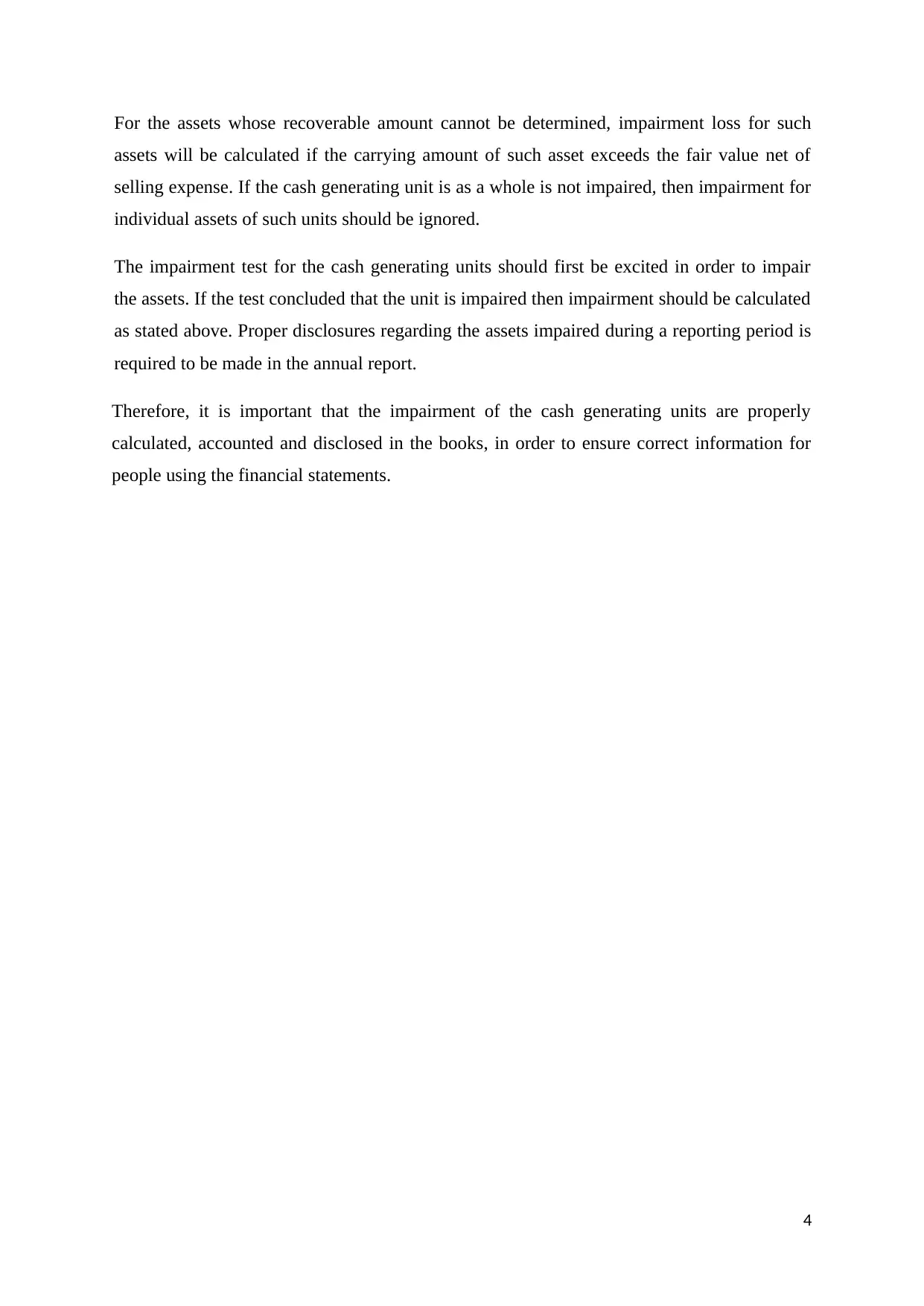
For the assets whose recoverable amount cannot be determined, impairment loss for such
assets will be calculated if the carrying amount of such asset exceeds the fair value net of
selling expense. If the cash generating unit is as a whole is not impaired, then impairment for
individual assets of such units should be ignored.
The impairment test for the cash generating units should first be excited in order to impair
the assets. If the test concluded that the unit is impaired then impairment should be calculated
as stated above. Proper disclosures regarding the assets impaired during a reporting period is
required to be made in the annual report.
Therefore, it is important that the impairment of the cash generating units are properly
calculated, accounted and disclosed in the books, in order to ensure correct information for
people using the financial statements.
4
assets will be calculated if the carrying amount of such asset exceeds the fair value net of
selling expense. If the cash generating unit is as a whole is not impaired, then impairment for
individual assets of such units should be ignored.
The impairment test for the cash generating units should first be excited in order to impair
the assets. If the test concluded that the unit is impaired then impairment should be calculated
as stated above. Proper disclosures regarding the assets impaired during a reporting period is
required to be made in the annual report.
Therefore, it is important that the impairment of the cash generating units are properly
calculated, accounted and disclosed in the books, in order to ensure correct information for
people using the financial statements.
4
Paraphrase This Document
Need a fresh take? Get an instant paraphrase of this document with our AI Paraphraser
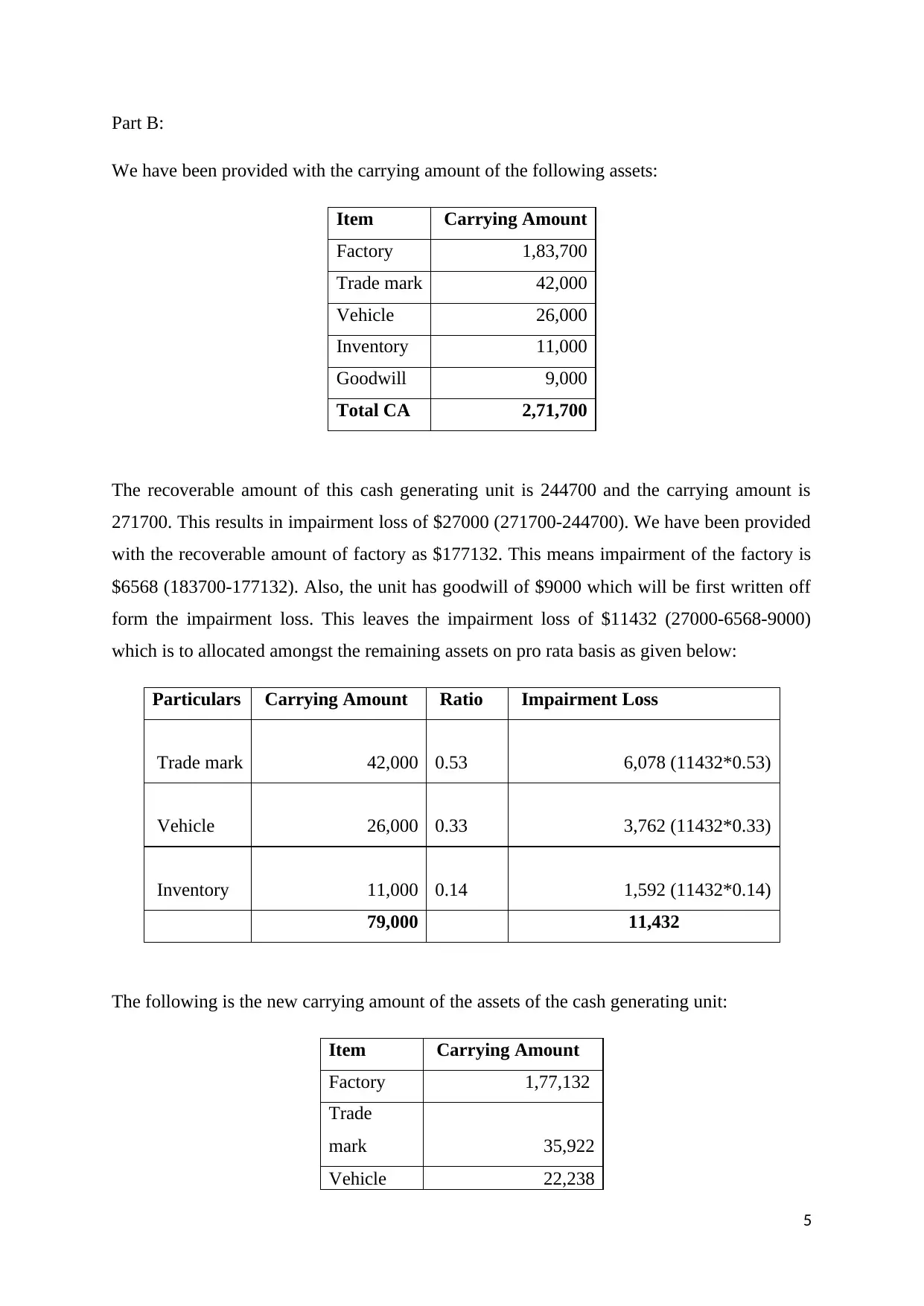
Part B:
We have been provided with the carrying amount of the following assets:
Item Carrying Amount
Factory 1,83,700
Trade mark 42,000
Vehicle 26,000
Inventory 11,000
Goodwill 9,000
Total CA 2,71,700
The recoverable amount of this cash generating unit is 244700 and the carrying amount is
271700. This results in impairment loss of $27000 (271700-244700). We have been provided
with the recoverable amount of factory as $177132. This means impairment of the factory is
$6568 (183700-177132). Also, the unit has goodwill of $9000 which will be first written off
form the impairment loss. This leaves the impairment loss of $11432 (27000-6568-9000)
which is to allocated amongst the remaining assets on pro rata basis as given below:
Particulars Carrying Amount Ratio Impairment Loss
Trade mark 42,000 0.53 6,078 (11432*0.53)
Vehicle 26,000 0.33 3,762 (11432*0.33)
Inventory 11,000 0.14 1,592 (11432*0.14)
79,000 11,432
The following is the new carrying amount of the assets of the cash generating unit:
Item Carrying Amount
Factory 1,77,132
Trade
mark 35,922
Vehicle 22,238
5
We have been provided with the carrying amount of the following assets:
Item Carrying Amount
Factory 1,83,700
Trade mark 42,000
Vehicle 26,000
Inventory 11,000
Goodwill 9,000
Total CA 2,71,700
The recoverable amount of this cash generating unit is 244700 and the carrying amount is
271700. This results in impairment loss of $27000 (271700-244700). We have been provided
with the recoverable amount of factory as $177132. This means impairment of the factory is
$6568 (183700-177132). Also, the unit has goodwill of $9000 which will be first written off
form the impairment loss. This leaves the impairment loss of $11432 (27000-6568-9000)
which is to allocated amongst the remaining assets on pro rata basis as given below:
Particulars Carrying Amount Ratio Impairment Loss
Trade mark 42,000 0.53 6,078 (11432*0.53)
Vehicle 26,000 0.33 3,762 (11432*0.33)
Inventory 11,000 0.14 1,592 (11432*0.14)
79,000 11,432
The following is the new carrying amount of the assets of the cash generating unit:
Item Carrying Amount
Factory 1,77,132
Trade
mark 35,922
Vehicle 22,238
5
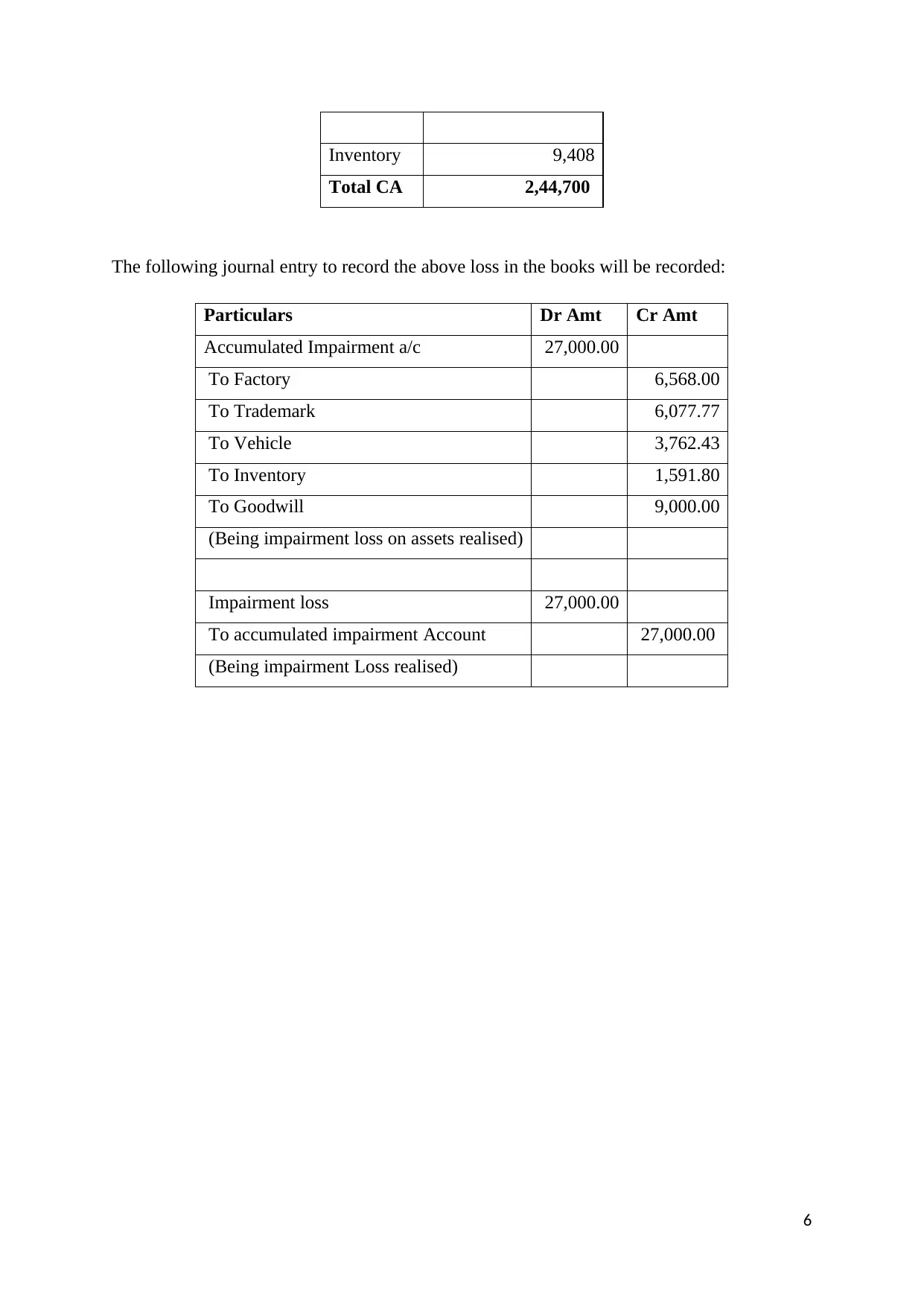
Inventory 9,408
Total CA 2,44,700
The following journal entry to record the above loss in the books will be recorded:
Particulars Dr Amt Cr Amt
Accumulated Impairment a/c 27,000.00
To Factory 6,568.00
To Trademark 6,077.77
To Vehicle 3,762.43
To Inventory 1,591.80
To Goodwill 9,000.00
(Being impairment loss on assets realised)
Impairment loss 27,000.00
To accumulated impairment Account 27,000.00
(Being impairment Loss realised)
6
Total CA 2,44,700
The following journal entry to record the above loss in the books will be recorded:
Particulars Dr Amt Cr Amt
Accumulated Impairment a/c 27,000.00
To Factory 6,568.00
To Trademark 6,077.77
To Vehicle 3,762.43
To Inventory 1,591.80
To Goodwill 9,000.00
(Being impairment loss on assets realised)
Impairment loss 27,000.00
To accumulated impairment Account 27,000.00
(Being impairment Loss realised)
6
⊘ This is a preview!⊘
Do you want full access?
Subscribe today to unlock all pages.

Trusted by 1+ million students worldwide
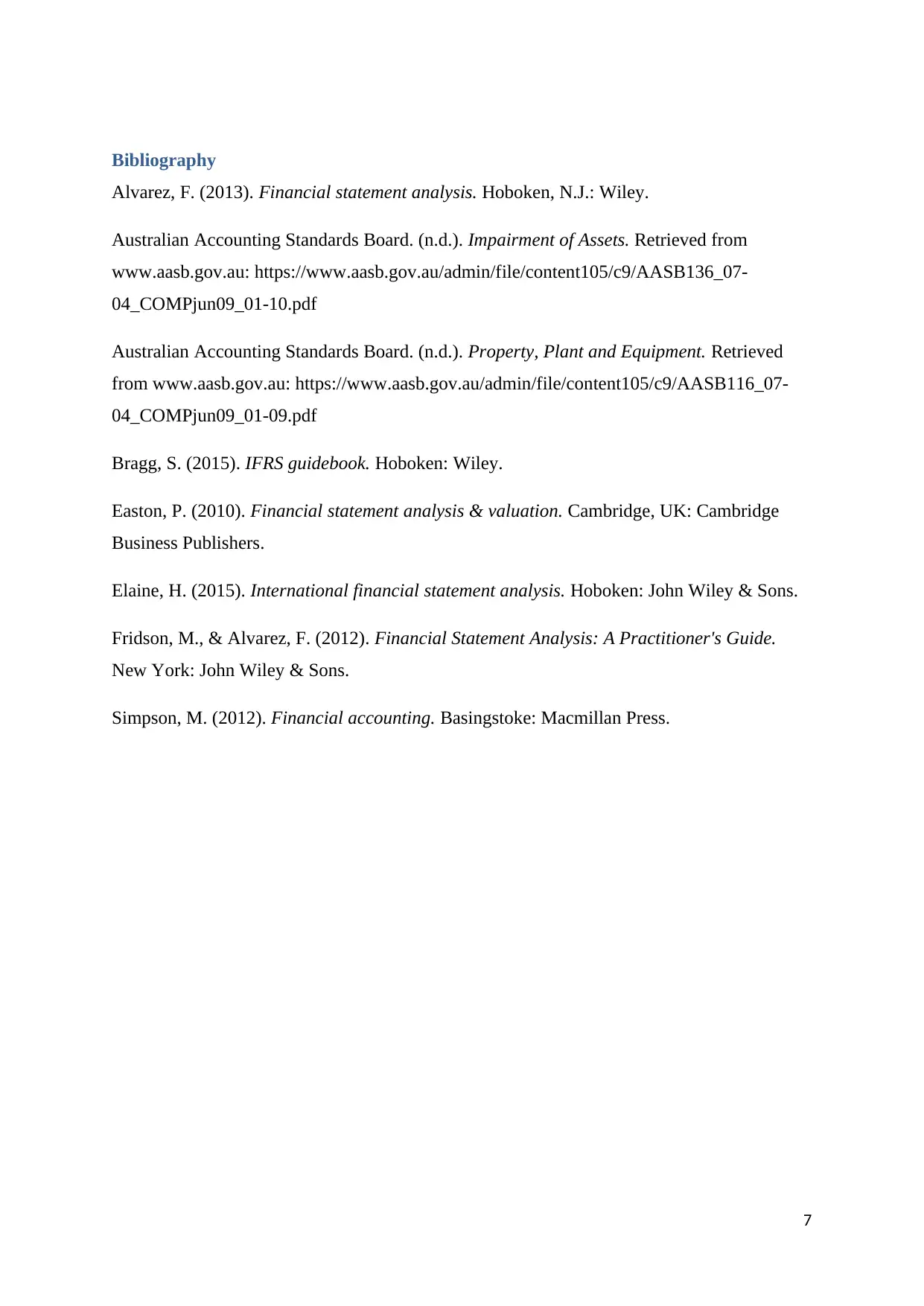
Bibliography
Alvarez, F. (2013). Financial statement analysis. Hoboken, N.J.: Wiley.
Australian Accounting Standards Board. (n.d.). Impairment of Assets. Retrieved from
www.aasb.gov.au: https://www.aasb.gov.au/admin/file/content105/c9/AASB136_07-
04_COMPjun09_01-10.pdf
Australian Accounting Standards Board. (n.d.). Property, Plant and Equipment. Retrieved
from www.aasb.gov.au: https://www.aasb.gov.au/admin/file/content105/c9/AASB116_07-
04_COMPjun09_01-09.pdf
Bragg, S. (2015). IFRS guidebook. Hoboken: Wiley.
Easton, P. (2010). Financial statement analysis & valuation. Cambridge, UK: Cambridge
Business Publishers.
Elaine, H. (2015). International financial statement analysis. Hoboken: John Wiley & Sons.
Fridson, M., & Alvarez, F. (2012). Financial Statement Analysis: A Practitioner's Guide.
New York: John Wiley & Sons.
Simpson, M. (2012). Financial accounting. Basingstoke: Macmillan Press.
7
Alvarez, F. (2013). Financial statement analysis. Hoboken, N.J.: Wiley.
Australian Accounting Standards Board. (n.d.). Impairment of Assets. Retrieved from
www.aasb.gov.au: https://www.aasb.gov.au/admin/file/content105/c9/AASB136_07-
04_COMPjun09_01-10.pdf
Australian Accounting Standards Board. (n.d.). Property, Plant and Equipment. Retrieved
from www.aasb.gov.au: https://www.aasb.gov.au/admin/file/content105/c9/AASB116_07-
04_COMPjun09_01-09.pdf
Bragg, S. (2015). IFRS guidebook. Hoboken: Wiley.
Easton, P. (2010). Financial statement analysis & valuation. Cambridge, UK: Cambridge
Business Publishers.
Elaine, H. (2015). International financial statement analysis. Hoboken: John Wiley & Sons.
Fridson, M., & Alvarez, F. (2012). Financial Statement Analysis: A Practitioner's Guide.
New York: John Wiley & Sons.
Simpson, M. (2012). Financial accounting. Basingstoke: Macmillan Press.
7
1 out of 7
Related Documents
Your All-in-One AI-Powered Toolkit for Academic Success.
+13062052269
info@desklib.com
Available 24*7 on WhatsApp / Email
![[object Object]](/_next/static/media/star-bottom.7253800d.svg)
Unlock your academic potential
Copyright © 2020–2025 A2Z Services. All Rights Reserved. Developed and managed by ZUCOL.





